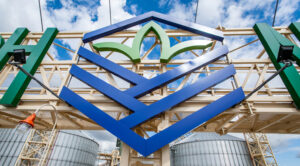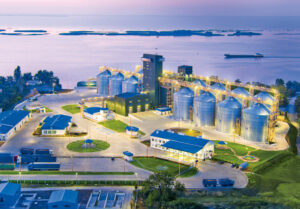
Kharkiv Tractor Plant (HTZ), a member of businessman Aleksandr Yaroslavsky’s DCH group, plans to initiate a preventive restructuring procedure.
According to the announcement of the company’s general shareholders meeting on May 9 published in the National Securities and Stock Market Commission’s (NSSMC) disclosure system, this is the only issue on the agenda.
The notice does not provide any details.
The preventive restructuring procedure was introduced by the Law “On Amendments to the Bankruptcy Code of Ukraine and Certain Other Legislative Acts of Ukraine on the Implementation of Directive 2019/1023 of the European Parliament and of the Council of the European Union”, which came into force on January 1 this year.
Preventive restructuring has secured the ability of companies to restore their financial stability before insolvency. The law provides more opportunities to resolve relations between the debtor and creditors.
As reported, in June 2020, the shareholders of Khartsyzsk Pipe initiated pre-trial rehabilitation of the company due to the threat of insolvency, and in August of the same year, the court approved a pre-trial rehabilitation plan for a period of two years.
In July 2022, Khartsyzsk Pipe applied to the court for amendments to the rehabilitation plan and approval of a new version, justifying this by the introduction of martial law in Ukraine and the constant shelling of Kharkiv, which led to a complete shutdown of the plant and the inability to pay its contractors.
On August 1, 2022, the court approved a new out-of-court rehabilitation plan and extended the out-of-court rehabilitation for three years.
In 2023, with the support of the United Nations World Food Program and the Swiss Mine Action Fund (FSD Ukraine), Khartsyzsk Pipe developed, certified and launched a demining machine based on the T-150 crawler tractor.
Founded in 1930, Khartsyzsk Tractor Plant specializes in the production of tractors and special equipment for use in agriculture, utilities, and construction. The plant does not report its financial and business results.
According to the Claroty Project, Khartsyzsk Pipe ended 2024 with a loss of UAH 359 million, compared to UAH 14.6 million in net profit a year earlier, with net income up 50.6% to UAH 300 million. Current liabilities increased to UAH 1.7 billion from UAH 251.7 million, but long-term liabilities decreased from UAH 1.2 billion to UAH 86 million.

Ukraine has reached an agreement in principle with the Eurobond Holders Committee on restructuring, Prime Minister Denys Shmyhal said.
“We are restoring debt sustainability. Today, we have reached agreements in principle with the Eurobond Holders Committee of Ukraine. This is an important step in the debt restructuring process that will save USD 11.4 billion in debt service over the next few years. It will save USD 11.4 billion on its servicing over the next three years and USD 22.75 billion by 2033,” Shmyhal wrote on his Telegram channel.
According to him, this way, Ukraine will be able to free up resources for urgent needs: defense, social protection and recovery.

Ukraine’s Debt Sustainability Analysis (DSA), conducted by the International Monetary Fund (IMF) as part of the third review of the EFF Extended Fund Facility (EFF), provides for a partial debt write-off to achieve such sustainability, so it is likely that such a write-off will be one of the points of Ukraine’s expected soon proposal to restructure its Eurobonds, analysts interviewed by Interfax-Ukraine believe.
“The IMF sees our public debt as sustainable with a debt/GDP ratio of 82% in 2028. At the same time, the IMF predicts that without restructuring, Ukraine’s public debt will grow to 91.2% of GDP in 2028, which means that to achieve sustainability, Ukraine should reduce this debt by 9.2% of GDP, or about $21 billion,” said Oleksandr Parashchiy, head of research at Concorde Capital.
“From this we can conclude that the IMF sees the potential to write off the state debt this year by about $15 billion. This is a very large amount, given that the main object of such a write-off should be Eurobonds, the total amount of which is $21.2 billion,” he said in a comment to Interfax-Ukraine on Thursday.
ICU Group financial analyst Mykhailo Demkiv believes that the memorandum is vaguely written, that it is impossible to clearly define the parameters of the restructuring, and everyone can see what they want there, but the market is expecting the debt to be written off, “except for some super-confident people.”
According to him, the IMF may be deliberately giving the Ministry of Finance a kind of backlash in the negotiations so as not to bind it too much and put it in a worse position.
“Optimists expect 30-40% (of write-offs), pessimists expect 40-50-75%. Personally, I expect that there will be a write-off, I am guided by 40%,” the expert told the agency. According to him, proposals to write off 70-75% contradict the statements of the Ministry of Finance about plans to return to the market.
Demkiv added that he does not expect the Ministry of Finance to make payments on Eurobonds (repayment + interest payment) until 2027, although there are optimists who see room for this in the DSA.
“As for the warrants, I don’t know if they will be included in the restructuring perimeter. There have been reports that investors want to block the restructuring of the guaranteed debt (of Ukrenergo) so that these securities are not included in the perimeter,” the ICU Group analyst also noted.
According to Paraschiy, it is right that the IMF excluded debts to Russia in the amount of about $3.6 billion (principal) to analyze Ukraine’s debt sustainability, because it is obvious to everyone that Ukraine will not repay or service them.
“What I see as the problem with the IMF’s calculation (not worrying about the 82% in 2028) is the calculation of the public debt for 2028. If we calculate all of Ukraine’s debt receipts, which the IMF itself predicts, and take into account all exchange rate differences, it turns out that Ukraine’s public and guaranteed debt at the end of 2028 will be approximately 87.3% of GDP,” added the head of Concorde Capital’s analytical department.
He explained that according to these calculations, Ukraine will need to reduce its debt by less than $9 billion (or about $6.4 billion this year) rather than $21 billion to reach the ratio of 82% of debt to GDP in 2028.
“That is, the difference/error in the forecast is quite significant for the amount of potential write-off – more than twice. It is not clear how the IMF explains this difference, except that it has planned some contingent liabilities and “other” for the equivalent of 4.3% of GDP,” Parashchiy said.
According to Demkiv, the positive reaction of Ukrainian Eurobond holders to the publication of the updated memorandum with the IMF, which resulted in a 10% rise in the cost of the securities, up to 30-38 cents per dollar, is due to the IMF’s improvement of its assessment of Ukraine’s debt at the end of last year from 87.1% of GDP to 82.9% of GDP.
“If the value of the debt improves, then less needs to be written off. And another point that some have noted is that the wording on the debt-to-GDP parameter has become a little softer: from “must” to recommended,” the ICU analyst explained, adding that such a positive reaction could also be influenced by the allocation of EU funds and improved prospects for receiving funds from the United States in April.
As reported, the IMF in an updated memorandum on the results of the third review of the program with Ukraine noted that “a decisive restoration of debt sustainability and maintenance of adequate international reserves will require a fairly deep debt adjustment.” The Fund added that even with such a “deep adjustment,” restoring debt sustainability would also require substantial fiscal adjustment and exceptional donor financing.
The documents do not explicitly mention the desirability of partial debt relief, but the IMF states that the public debt should be reduced to 82% of GDP by 2028 and to 65% of GDP in 2033, while under the baseline scenario it will be higher by almost 9 percentage points and almost 6 percentage points, respectively, in these years.
The restructuring goals also state that gross financing needs should average 8% of GDP in the post-program period (2028-2033).
In addition to reducing the debt to 82% of GDP by 2028, the restructuring also aims to ease the debt service flow on external obligations to 1-1.8% of GDP (from $1.9 billion in 2024 to $3.5 billion in 2027).
According to the third review, the Ukrainian authorities and their debt advisors are finalizing technical work to design a debt operation that meets the objectives of the debt sustainability program. They plan to present initial proposals to creditors in the near future, in line with their intention to complete the restructuring by mid-year and before the debt moratorium expires in August 2024.
“As part of the treatment of external commercial debt, which we plan to complete by mid-2024, we will strive to obtain adequate debt relief, including from the restructuring of external commercial debt, in 2024 and beyond in accordance with the program parameters,” the Ukrainian authorities said in an updated memorandum on financial and economic policy.
As reported, on the eve of the IMF’s approval in late March 2023 of a new four-year, $15.6 billion EFF program for Ukraine, the Group of Official Creditors of Ukraine (the Paris Club) provided financial guarantees for this program following a meeting with representatives of the IMF and the WB. They provide for the extension of the standstill on Ukraine’s debt payments to the Group’s countries for the period of its validity (2023-2027). The condition for such a postponement is similar actions on the part of Ukraine’s private external creditors, mainly Eurobond holders.
Recently, Reuters reported that foreign holders of Ukraine’s Eurobonds are negotiating the formation of a creditors’ committee to conduct a restructuring dialogue that could begin on the eve of the IMF’s spring meeting scheduled to begin on April 17 in Washington.

State-owned Ukreximbank (Kyiv) and one of the largest grain market operators in Ukraine, JV Nibulon LLC (Mykolaiv), signed agreements on long-term debt restructuring of the company’s financial obligations in late January, the press service of the financial institution reported on Tuesday.
“Thanks to this, the parties ensured, on the one hand, a working asset and the return of funds to the state bank, and, on the other hand, an acceptable level of financial burden for one of the market leaders, which makes it possible for it to function successfully,” the state bank’s website reports.
Andriy Vadatursky, CEO of the agricultural holding, noted that Ukreximbank is the company’s largest creditor, and cooperation with the bank started 27 years ago.
In particular, he recalled that earlier, thanks to the support of Ukreximbank, Nibulon managed to build a sea transshipment terminal in Mykolaiv, and in 2013-2014 the company’s largest loan portfolio to the bank was recorded at $165 million, which, according to him, “characterizes the level of cooperation and mutual understanding that we have achieved in previous years and confirmed now during the restructuring.”
“I am convinced that now we should not wait for help from abroad, we should look for support and understanding on our territory. We have found this support in our Ukrainian banks, which are the embodiment of government policy,” Vadatursky stated.
JV Nibulon LLC was established in 1991. Prior to the Russian military invasion, the grain trader had 27 transshipment terminals and crop reception complexes, a one-time storage capacity of 2.25 million tons of agricultural products, a fleet of 83 vessels (including 23 tugs), and owned the Mykolaiv Shipyard.
“Before the war, Nibulon cultivated 82 thousand hectares of land in 12 regions of Ukraine and exported agricultural products to more than 70 countries. In 2021, the grain trader exported the highest ever 5.64 million tons of agricultural products, reaching record volumes of supplies to foreign markets in August – 0.7 million tons, in the fourth quarter – 1.88 million tons, and in the second half of the year – 3.71 million tons.
Nibulon’s losses due to Russia’s full-scale military invasion in 2022 exceeded $416 million.
Currently, the grain trader is operating at 32% of capacity, has created a special unit to clear agricultural land of mines, and was forced to move its headquarters from Mykolaiv to Kyiv.
According to the National Bank of Ukraine, as of November 1, 2023, Ukreximbank ranked 3rd (UAH 255.01 billion) among 63 banks operating in the country in terms of total assets.

One of the largest grain market operators in Ukraine, JV Nibulon LLC (Mykolaiv), has agreed to restructure its loan agreement with OTP Bank, the grain trader’s press service reported on Facebook.
“We are grateful to the bank for the speed of decision-making and constructive approach in resolving the issue of restructuring the company’s financial obligations in such difficult times for the Ukrainian economy,” said Iryna Levkivska, CFO of the grain trader.
At the same time, Nibulon noted that the addition of another bank with foreign capital to the proposed restructuring terms once again emphasizes the confidence of foreign financial institutions in the company and Ukrainian business in general.
As reported earlier, Nibulon agreed with Kredobank to restructure the terms of the loan agreement, which was extended for six years with a preferential interest rate and deferred repayment of the principal. A similar agreement on loan prolongation for 6 years was reached with Creditwest Bank Ukraine (JSC West Finance and Credit Bank). An agreement on long-term restructuring of financial liabilities was signed with JSB Ukrgasbank.
JV Nibulon LLC was established in 1991. Prior to the Russian military invasion, the grain trader had 27 transshipment terminals and crop reception complexes, a one-time storage capacity of 2.25 million tons of agricultural products, a fleet of 83 vessels (including 23 tugs), and owned the Mykolaiv Shipyard.
“Before the war, Nibulon cultivated 82 thousand hectares of land in 12 regions of Ukraine and exported agricultural products to more than 70 countries.
In 2021, the grain trader exported the highest ever 5.64 million tons of agricultural products, reaching record volumes of supplies to foreign markets in August – 0.7 million tons, in the fourth quarter – 1.88 million tons, and in the second half of the year – 3.71 million tons.
Nibulon’s losses from Russia’s full-scale military invasion have reached $400 million. The grain trader is currently operating at 30% of capacity and has set up a special unit to clear agricultural land of mines.

DTEK Energy has agreed on the terms of restructuring eurobonds and the major bank debt with the committees of creditors-holders of eurobonds and banks, the group’s press service has said.
The company notes that the completion of restructuring will ensure the stable operation of the company in the long term, flexible debt service mechanics, taking into account financial forecasts and an unstable external conjuncture.
DTEK’s Strategy and Finance Director Oleh Tymkiv, whose comment is given in the report, indicated that DTEK was building the negotiation process “as a reliable partner fulfilling its obligations.”
“This allowed to maintain constructive relations and balance the company’s loan servicing capabilities and continue its development,” he stressed.
According to him, during the negotiation process, DTEK was able to make sure that the creditors fully understand the consequences of the crisis caused by the COVID-19 pandemic, both on the country’s economy and on the energy industry.
“This was reflected in their balanced constructive position, aimed primarily at finding a compromise solution. As a result, we managed to reach the best conditions for both sides of the new agreement,” Tymkiv summed up.